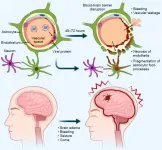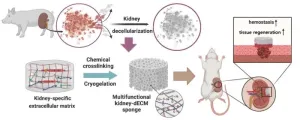Young adults reduced drinking during and after pandemic
A new study finds heavy-drinking young adults decreased alcohol intake during the pandemic
2024-05-02
(Press-News.org)
A new study examined the drinking levels and patterns of young adults before, during and after the pandemic. The researchers found alcohol use and alcohol-related problems substantially decreased in heavy-drinking young adults during the pandemic, and these decreases were still evident as the pandemic began to wane. The results are available in the May 2 issue of the journal Nature Mental Health.
“The pandemic gave us a unique opportunity to see how wide-spread mitigation measures like social distancing and bar/restaurant closures may have affected alcohol consumption,” said lead author Kasey Creswell, associate professor of psychology at Carnegie Mellon University. “We focused on young adults who were engaging in heavy drinking before the onset of the pandemic, and we followed them over time to see if there were any pandemic-related changes to their alcohol consumption and alcohol problems.”
Unlike most prior studies of drinking habits during the pandemic, this study prospectively examined the drinking patterns of 234 heavy-drinking young adults ages 21 to 29 years from before to well after the onset of the pandemic. Prior to the pandemic, these individuals had to report binge drinking at least four times in the past month, defined as consuming 5 or more drinks per occasion (for males) and 4 or more drinks per occasion (for females). The team gathered data every six months from February 2018 to March 2022.
Results showed that these young adults significantly reduced how much and how often they were drinking from before to after the onset of the pandemic. Notably, they decreased their monthly alcohol consumption by nearly 13 drinks, and they also reported significantly fewer alcohol-related problems. Notably, these reductions in alcohol use and alcohol problems were still evident up to two years after the start of the pandemic.
According to Creswell, the results may in part be explained by the environment. Alcohol was still available to these young adults during the pandemic, but the context in which they were drinking likely changed pretty drastically for most of them. Due to pandemic restrictions, they weren’t able to drink with friends at parties or in bars, contexts that are usually associated with heavy alcohol use in young adults. The study authors highlight the impact of social settings in problematic alcohol use.
“Alcohol is a social drug,” said Aidan Wright, the Phil F. Jenkins Research Professor of Depression at the Eisenberg Family Depression Center and professor of psychology at the University of Michigan. Wright is a contributing author on this study. “These results highlight the social nature of drinking and speak to the importance of the social context in driving drinking behavior.”
The study also found significant decreases in negative emotions during the pandemic but did not find any change in the use of alcohol as a coping mechanism during the pandemic. The results for men and women followed similar patterns.
“Although there are overall trends that show declining patterns in drinking, it doesn’t mean that people did not have high periods of drinking,” said Wright. “The averages hide a lot of information, smearing over a lot of different trajectories that people took.”
Of note, solitary drinking did increase during the pandemic, with participants reporting a 4% increase in this habit. Creswell’s previous research has associated solitary drinking with an increased risk of developing alcohol problems. Creswell acknowledges the increase in solitary drinking in this study remained fairly muted, considering the constraints in accessing alcohol in social settings due to pandemic-related mitigation measures.
“Drinking to cope is the main reason young people engage in solitary drinking,” said Creswell. “But in this study, we actually saw a decrease in drinking to cope motives along with decreases in negative affectivity, so we think this increase in solitary drinking is less of a signal of something problematic happening and more a result of pandemic-related restrictions on social drinking settings.”
The study is limited to drinking-age adults (21 years or older) in a primarily white population. The results may not be broadly generalizable to other groups. Creswell notes that future studies are needed to evaluate the effect of the pandemic on alcohol consumption and related problems in different populations.
Alcohol-related problems were assessed in the study using the Alcohol Use Disorder Identification Test and the Brief Young Adult Alcohol Consequences Questionnaire. Negative affect was assessed using the Personality Inventory for DSM-5.
“The pandemic was really hard on a lot of people, but for this group of young adults who were engaging in heavy drinking, the pandemic seems to have had a long-term positive effect.”
###
Creswell and Wright were joined by Greta Lyons and Francisco Carrillo-Álvarez at CMU, Garrett Hisler at the University of Pittsburgh and Catharine Fairbairn at the University of Illinois at Urbana-Champaign on the study, titled “Changes in Alcohol Consumption and Alcohol Problems from Before to After the Onset of the COVID-19 Pandemic: A Prospective Study in a Sample of Heavy Drinking Young Adults.” The project received support from the National Institutes of Health.
END
ELSE PRESS RELEASES FROM THIS DATE:
2024-05-02
Northwestern University engineers have developed a new artificial intelligence (AI) algorithm designed specifically for smart robotics. By helping robots rapidly and reliably learn complex skills, the new method could significantly improve the practicality — and safety — of robots for a range of applications, including self-driving cars, delivery drones, household assistants and automation.
Called Maximum Diffusion Reinforcement Learning (MaxDiff RL), the algorithm’s success lies in its ability to encourage robots to explore their environments as randomly as possible in order to gain a diverse set of ...
2024-05-02
Play is widespread, but far from ubiquitous, across the animal kingdom. Especially common in mammals, play is also known to occur in taxa as diverse as birds, fish, octopuses, and even insects. But what is its function, given that natural selection never selects fun for its own sake? One prominent hypothesis is that play is beneficial to individuals because it allows them to practice skills needed later in life.
Now, a study in Frontiers in Ethology has shown that male baby chickens play far more than females. This result is of interest given that domestic ...
2024-05-02
Osaka, Japan – Probiotics offer a range of health benefits, but their adverse effects can occasionally lead to bacteremia, wherein bacteria circulate in the bloodstream throughout the body. In Japan, Clostridium butyricum (C. butyricum) MIYAIRI 588 is commonly used, yet the prevalence and characteristics of bacteremia caused by this strain, as well as its bacteriological and genetic profile, remain unknown.
A research team from the Graduate School of Medicine, Osaka University, found an association between bacteremia and probiotics from a study of the genetic materials of bacteria in hospitalized patients with bacteremia.
From September 2011 to February 2023, ...
2024-05-02
Medical College of Georgia scientists report that a gene previously implicated in the development of atherosclerotic lesions in coronary arteries could be key to understanding why many people don’t benefit from the most used therapy for neovascular age-related macular degeneration (AMD), a leading cause of blindness.
AMD is a condition characterized by abnormal blood vessel growth in the back of the eye. It is highly prevalent in the elderly and people with diabetes, obesity, and many other chronic metabolic diseases. Excessive vascular growth damages the macula, the part of the eye that translates light into image signals.
Anti-VEGF therapy, which blocks vascular ...
2024-05-02
Osaka, Japan – It might start simply, with a cough or sneeze…but in some cases, the flu virus can make its way to your brain, causing serious symptoms or even death through a disease known as influenza-associated encephalopathy (IAE).
Now, in a study published in Acta Neuropathologica, researchers have revealed that IAE may be caused by the virus entering the brain through a specific cell type, and have identified possible treatment strategies.
Although IAE is increasingly common, surprisingly little is known about ...
2024-05-02
In the shadowy world of counterfeit alcoholic spirit production, where profits soar and brands are exploited, the true extent of this illegal market remains shrouded.
Now scientists from the International Centre for Brewing and Distilling (ICBD) at Heriot-Watt University, in Edinburgh, Scotland, working alongside Dr John Edwards of Process NMR Associates, based in New York, are compiling a database to test, compare and log counterfeit spirits.
The research has featured in a paper, titled, Worldwide Illicit and Counterfeit ...
2024-05-02
Charge-recharge cycling of lithium-superrich iron oxide, a cost-effective and high-capacity cathode for new-generation lithium-ion batteries, can be greatly improved by doping with readily available mineral elements.
The energy capacity and charge-recharge cycling (cyclability) of lithium-iron-oxide, a cost-effective cathode material for rechargeable lithium-ion batteries, is improved by adding small amounts of abundant elements. The development, achieved by researchers at Hokkaido University, Tohoku University, and Nagoya Institute of Technology, is reported in the journal ACS Materials Letters.
Lithium-ion batteries have become indispensable in modern life, used in a multitude ...
2024-05-02
CORVALLIS, Ore. – Artificial intelligence analysis of data gathered by acoustic recording devices is a promising new tool for monitoring the marbled murrelet and other secretive, hard-to-study species, research by Oregon State University and the U.S. Forest Service has shown.
The threatened marbled murrelet is an iconic Pacific Northwest seabird that’s closely related to puffins and murres, but unlike those birds, murrelets raise their young as far as 60 miles inland in mature and old-growth forests.
“There are very few species like it,” said co-author Matt Betts of the OSU College of Forestry. “And there’s no ...
2024-05-02
Professor Dong-Woo Cho from the Department of Mechanical Engineering along with Jae Yun Kim, a PhD candidate, from the School of Interdisciplinary Bioscience and Bioengineering and Tugce Sen, a PhD student, from Department of Mechanical Engineering at POSTECH, teamed up with Professor Jae Yeon Lee from Daegu Haany University's Department of Companion Animal Health. Together, they crafted a material aimed at swiftly staunching kidney bleeding and facilitating wound recovery. Their research featured in the online edition of Biomaterials, an ...
2024-05-02
MIAMI, FLORIDA (May 1, 2024) – Patients in South Florida with metastatic melanoma will soon have access to the first cellular therapy for this advanced form of skin cancer, following its recent approval by the Food and Drug Administration (FDA). The therapy, known as tumor-infiltrating lymphocyte therapy, or TIL, uses patients’ own immune cells to battle their cancer. It will be available to patients at Sylvester Comprehensive Cancer Center at the University of Miami Miller School of Medicine as South Florida’s only center offering ...
LAST 30 PRESS RELEASES:
[Press-News.org] Young adults reduced drinking during and after pandemic
A new study finds heavy-drinking young adults decreased alcohol intake during the pandemic








